Cary Town Council: SearStone, North Carolina Courage and More
Cary, NC – At the latest Cary Town Council meeting, Town Council heard the latest amendment proposal for SearStone’s Phase II, held the Public Hearing for the upcoming bond referendum, looked at a new rezoning plan for the Twyla Road area and also recognized the North Carolina Courage’s various successes.
SearStone Amendment
The agenda item at the Thursday, July 18, 2019 Cary Town Council meeting that saw by far the most discussion was a Public Hearing on a proposal to amend the Planned Development District (PDD) for senior living community SearStone’s Phase II. The PDD rezoning was originally passed nearly 20 years ago and has come for amendments multiple times since then.
This amendment changes the positioning of the buildings, getting rid of several smaller multi-family buildings and instead creating one large integrated building, including housing and other uses. This building would also take up space previously set aside for the SearStone conservatory. There are several new community gathering spaces proposed, including one in the spot where one of the multi-family buildings would have stood.
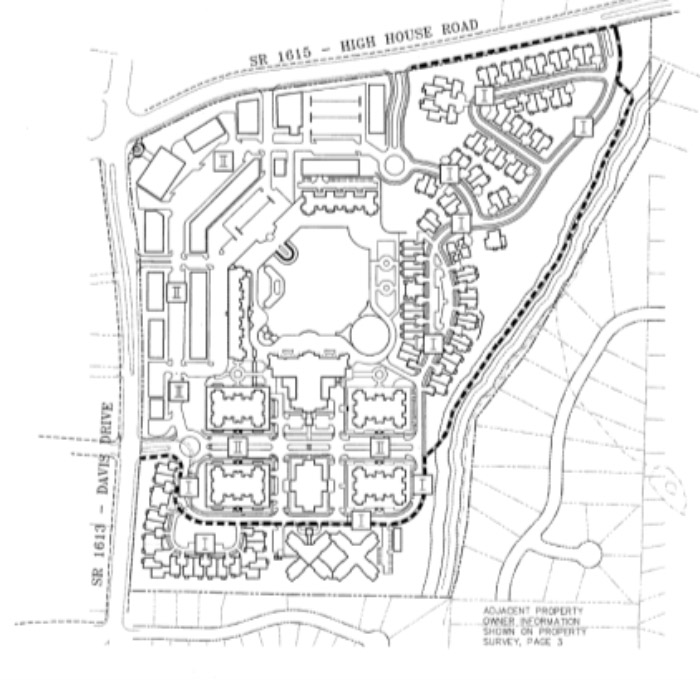
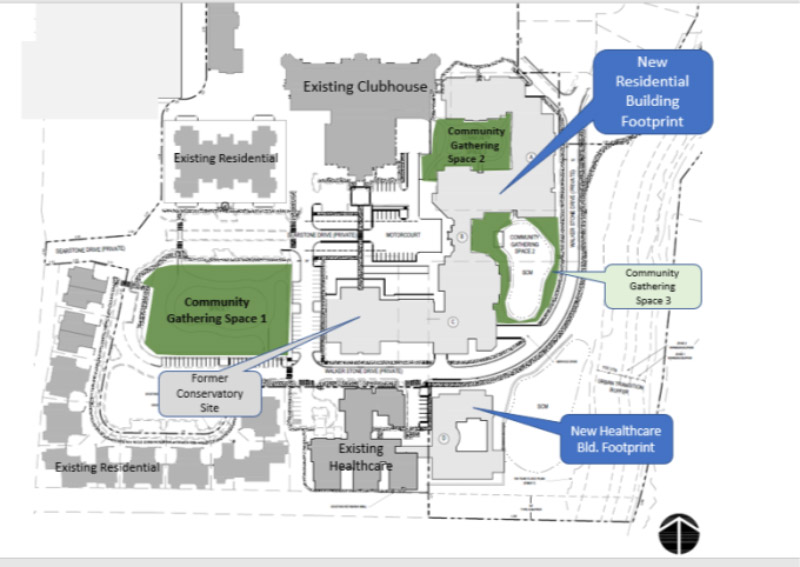
The applicant said SearStone needs to expand to serve an aging population, both in Cary at large and in SearStone itself, adding that SearStone has a 70-person waiting list. SearStone also has a new owner, Samaritan Housing Foundation, Inc., and a representative for Samaritan spoke during the Public Hearing to say the conservatory was never a realistic proposal.
There was one other speaking during the Public Hearing: a current resident who said the proposed larger building will block the view out of his window.
During discussion, most of Town Council did not sound optimistic about what is newly proposed. Several council members talked about how the PDD has changed bit by bit over the past 20 years with constant amendments, with Council Member Jack Smith using the analogy of “death by 1,000 cuts,” while calling this new plan a “C- idea.”
Both Cary Mayor Harold Weinbrecht and Council Member Jennifer Robinson talked about how the conservatory was a major selling point of the original rezoning, and Weinbrecht even said he did not think it would have passed without it. Additionally, several council members were concerned that the community gathering spaces had no conditions or details included.
“It would be great if they had some public value,” said Mayor Pro Tem Lori Bush.
Conversely, Council Member Don Frantz said the “dire need” for more senior housing in Cary makes the expansion of a place such as SearStone important to Cary.
“We are the second oldest town in the state,” Frantz said.
The PDD amendment then went to the Planning and Zoning Board for their recommendation.
Twyla Road North Rezoning
The other Public Hearing that saw public input was a return of a May 2019 case for a 36.84 acre rezoning by Morrisville Parkway and NC-540, along Twyla Road. The applicant made changes to the distribution of commercial uses and residential space, enough that the Land Development Ordinance requires a new Public Hearing.
Now, the rezoning calls for 395 multi-family residential units, between 10,000 and 40,000 square feet of commercial space and a hotel with between 140 and 200 rooms. Conditions on the commercial uses prevent it from being used as a nightclub, bar or theater.
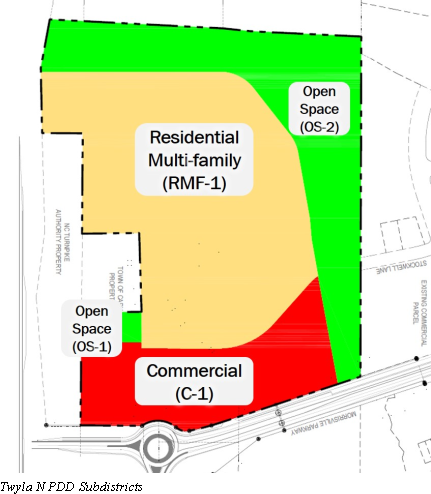
There was only one speaker at the Public Hearing, and he also spoke at the May 2019 hearing. He said he was disappointed by what he saw as minor changes and urged council to consider how this rezoning would impact neighbors there.
Members of town council made extensive comment directed at this speaker to say that no votes are a “done deal” or that they make deal between one another in chambers in private. Bush also followed up on her questions about Twyla Road getting curb and gutter access from the May 2019 meeting. While they can have it installed, it is not conditional, which Bush stressed was important. This particular site is also impacted by a stream buffer so Bush acknowledged installation would be difficult.
The proposed rezoning was then sent to the Planning and Zoning Board for their recommendation.
Other Public Hearings
While the remaining Public Hearings on the agenda deal with significant town business, they had neither speakers nor comment from council.
The first of these was the Public Hearing on the 2019 bond referendums, which will be for $112 million for parks and $113 million for transportation. With no speakers or council comment, the bond vote is set for the Tuesday, October 8, 2019 election.
Also on the agenda was an amendment to Cary’s Land Development Ordinance for quasi-judicial hearings. Currently, Town Council holds all quasi-judicial hearings but this would shift that so, instead, quasi-judicial hearings are held by the Zoning Board of Adjustment. However, mixed use rezoning cases and Vested Rights cases would still have their quasi-judicial hearings in front of Town Council.
At the May 9 town retreat, Town Council said they wanted to make this move, which is how most municipalities in North Carolina do things. The ordinance amendment was then sent to the Planning and Zoning Board for their recommendation.
And finally, there were two annexations, one on Wake Robin Lane and one on Carpenter Fire Station Road. Both annexations passed anonymously with no discussion.
Public Speaks Out
During the Public Speaks Out portion of the meeting, there were two speakers. One was a representative for a variety of local groups, including the Umstead Coalition, the local chapter of the Sierra Club and several cycling organizations. He spoke at length about his opposition to sale of land around Raleigh-Durham International Airport, bordering Umstead Park, to be sold for a quarry. The speaker also urged Town Council to oppose this plan.
The only other speaker talked about stormwater concerns, particularly as development exacerbates it by creating more impervious surface. While town standards now require all new construction to offset stormwater, the speaker also specifically talked about Cary’s Land Development Ordinance with regards to stormwater runoff and said it is insufficient because it only deals with peak volumes of rain fall.
Reports and Recognitions
As part of the town manager’s report, Cary Manager Sean Stegall talked about a rash of gas line, water line and other utility damages caused by the installation of AT&T and Google fiber lines. Stegall was very direct with his criticism and said it came down to poor quality work.
“It’s as bad as I’ve ever seen it,” Stegall said.
Stegall also said Cary is limited in what it can do by state and federal regulations but added Cary is seeking legal remedies.
This Town Council meeting also saw a recognition of the North Carolina Courage, not only for their historic successes since moving to Cary two years ago, but also for several of its players participating in the 2019 FIFA Women’s World Cup. As part of his declaration, Weinbrecht named July 2019 as “North Carolina Courage Month.”
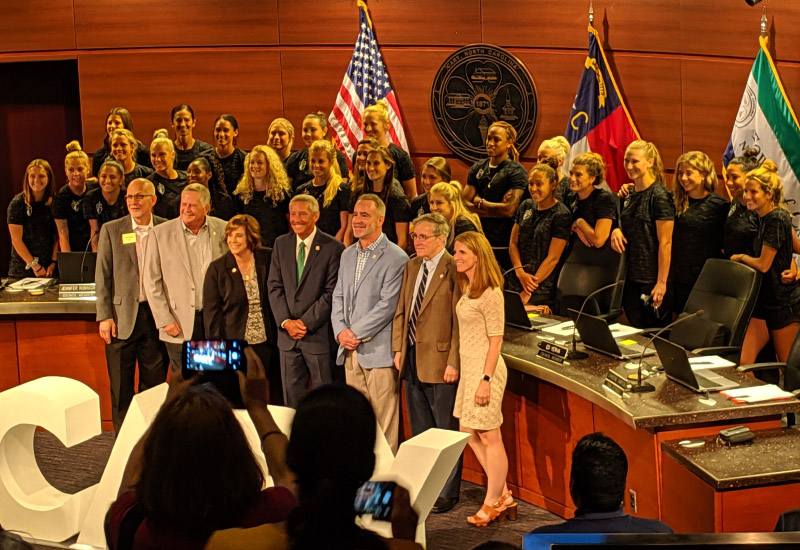
Story by Michael Papich. Photos by Michael Papich and the Town of Cary.

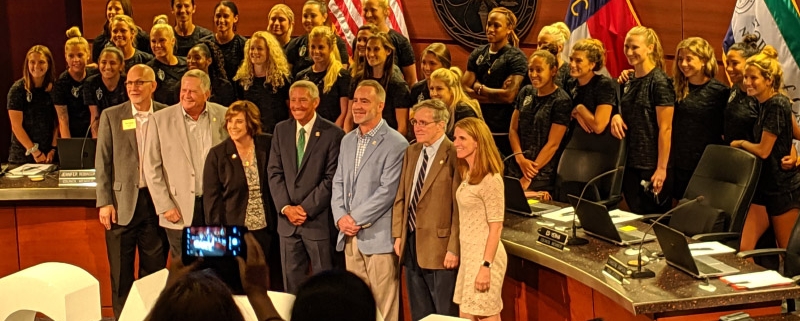


What is a “C-idea”?
C-, as in, C minus. Hope that clears things up.
Thanks Michael. That does clear things up, but I don’t agree with Jack. I’d give the proposal a higher grade.
“It’s as bad as I’ve ever seen it,” Stegall said.
That’s an understatement if I ever heard one. The AT&T crew cut the Spectrum/TWC feeds to at least 5 houses in my neighborhood, and a water line further down the street. Even though the locations had been clearly marked by the “Call before you dig” folks. We started thinking it was a conspiracy to try and get us to switch to AT&T’s fiber. But one of my Spanish speaking neighbors talked to the crew, and they claimed, believe it or not, no one had told them what the markings on the ground meant.
Dear Mr. Papich,
Thank you for your coverage of the Council meetings. In a paragraph on the Public Speaks Out of July 18, you state that the “town standards now require all new construction to offset stormwater.” I’m not sure what you mean by this.
My point was that the Town’s ordinances on stormwater do not limit or regulate the volume (amount) of water that can flow off developed property. The ordinances deal only with the peak rate of flow of that water, i.e., how fast the water may flow off a property at that point in time when it is flowing fastest.
My suggestion, respectfully made, was that the Town should consider a statutory means of regulating the amount of development runoff, because the Town’s flooding is a function of too much volume.